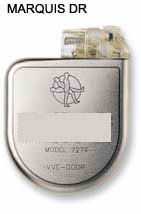Cardiac Procedures
Implantable Defibrillator (AICD)
 Implantable defibrillators or automatic, implantable cardioverter-defbrillators
are complex electrical devices designed to monitor the hearts rhythm and
deliver lifesaving electrical therapy should the patient suffer a life
threatening arrhythmia. Patients with weakened hearts from whatever cause
are at increased risk for cardiac rhythm disturbances or arrhythmias. These
may be symptomatic or asymptomatic. Arrhythmias from the lower chamber
or ventricle may be intermittent or continuous, regular or irregular. Some
of these can be life threatening. The most dangerous are sustained ventricular
tachycardia (VT), a fast continuous rhythm coming from the ventricle (usually
left ventricle) and ventricular fibrillation (VFIB), a totally irregular
and erratic rhythm. In ventricular tachycardia the patient may remain conscious
and experience mild to severe symptoms of dizziness, shortness of breath
or chest pain. If the VT is sufficiently fast the patient may lose consciousness.
In ventricular fibrillation the ventricles do not pump blood effectively
and loss of consciousness occurs. Unless resuscitative measures are applied
promptly, the patient will not survive. Implantable defibrillators or automatic, implantable cardioverter-defbrillators
are complex electrical devices designed to monitor the hearts rhythm and
deliver lifesaving electrical therapy should the patient suffer a life
threatening arrhythmia. Patients with weakened hearts from whatever cause
are at increased risk for cardiac rhythm disturbances or arrhythmias. These
may be symptomatic or asymptomatic. Arrhythmias from the lower chamber
or ventricle may be intermittent or continuous, regular or irregular. Some
of these can be life threatening. The most dangerous are sustained ventricular
tachycardia (VT), a fast continuous rhythm coming from the ventricle (usually
left ventricle) and ventricular fibrillation (VFIB), a totally irregular
and erratic rhythm. In ventricular tachycardia the patient may remain conscious
and experience mild to severe symptoms of dizziness, shortness of breath
or chest pain. If the VT is sufficiently fast the patient may lose consciousness.
In ventricular fibrillation the ventricles do not pump blood effectively
and loss of consciousness occurs. Unless resuscitative measures are applied
promptly, the patient will not survive.
An AICD is inserted like a pacemaker with an electrical lead implanted
into the right ventricle of the heart via the large veins leading from
the arm to the heart. The device in implanted under the skin below the
collarbone and is about the size of a large pacemaker. The circuitry
of the AICD continuously monitors the heart’s rhythm. If a patient
develops an excessively fast pulse the AICD delivers an internal shock
designed
to restore normal rhythm. The AICD continues to monitor and may deliver
multiple shocks if the first ones are ineffective. AICDs also have backup
pacing capability to deal with excessively slow heart rates. Some AICDs
also have leads implanted into the right atrium or left ventricle to
provide dual chamber pacing and/or resynchronization therapy.
AICDs are not indicated for all patients with heart failure. Indications
for AICDs include patient with symptomatic sustained or non-sustained
VT and patients with recurrent VFIB. It has been shown that AICDs may
be of
benefit in patients without symptomatic ventricular arrhythmia. Selection
criteria in these cases include patients with weakened left ventricles
(LVEF < 30%) who also have a widened QRS complex (IVCD) usually
greater than 0.15 seconds.
|